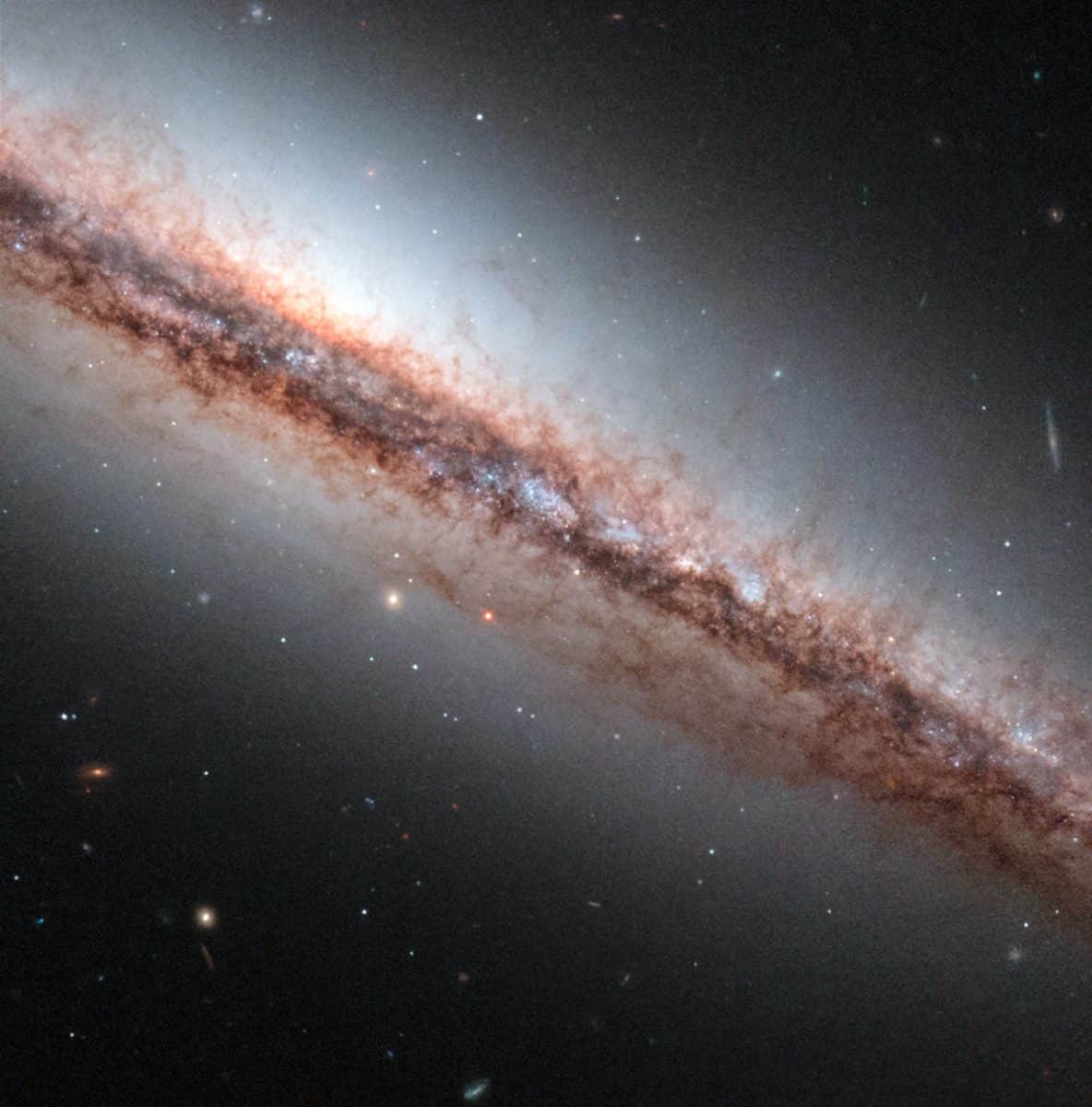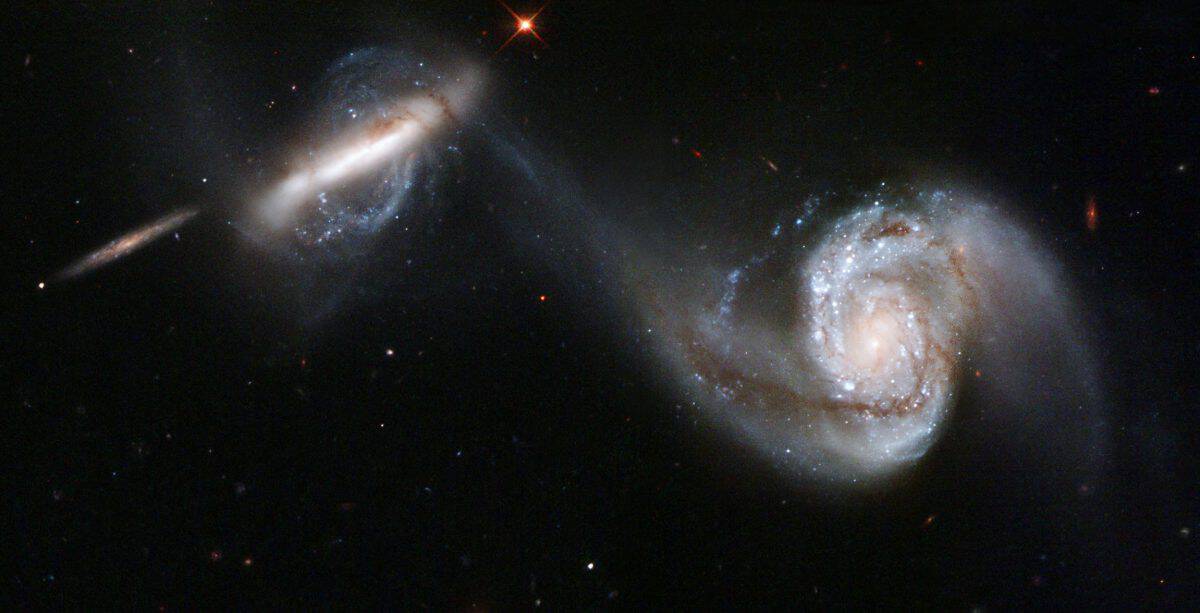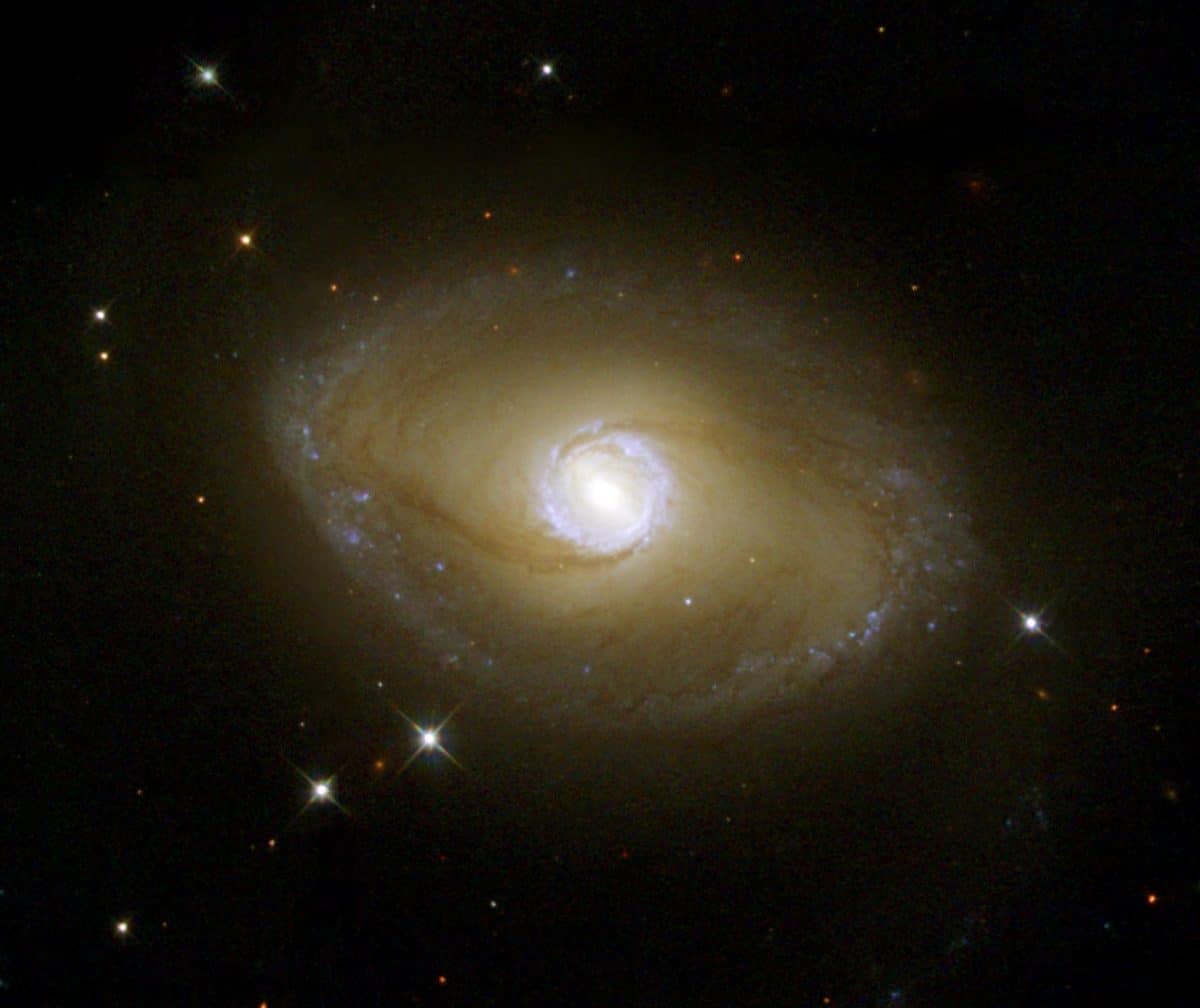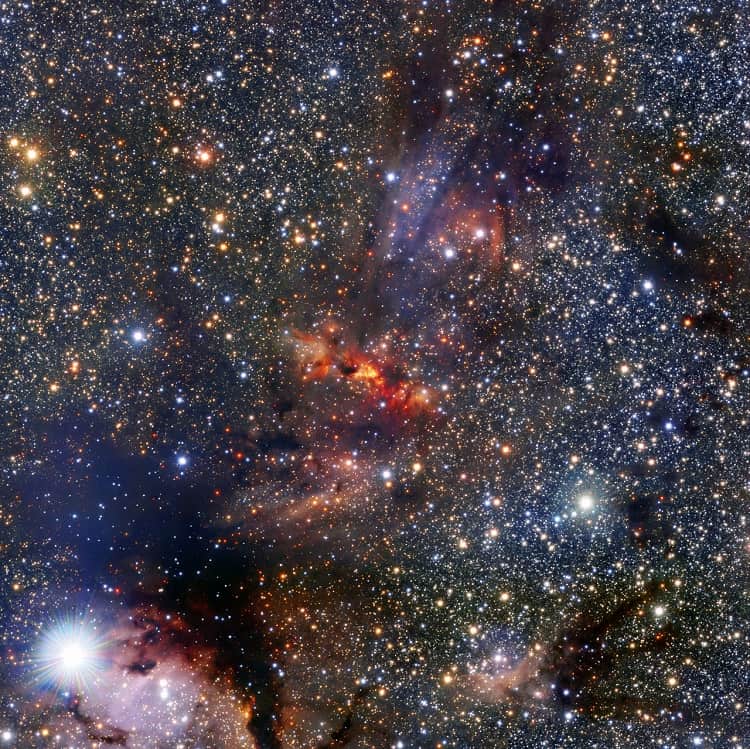Blog
In this image the NASA/ESA Hubble Space Telescope takes a close look at the spiral galaxy NGC 4217, 60 million light-years away. The galaxy is seen almost perfectly edge on and is a perfect candidate for studying the nature of extraplanar dust structures — the patterns of gas and dust above and below the plane on the galaxy, seen here as brown wisps coming off NGC 4217. These tentacle-like filaments are visible in the Hubble image only because the contrast with their surroundings is so high. This implies that the structures are denser than their surroundings. The image shows dozens of dust structures some of which reach as far as 7000 light-years away from the central plane. Typically the structures have a length of about 1000 light-years and are about 400 light-years in width. Some of the dust filaments are round or irregular clouds, others are vertical columns, looplike structures or vertical cones. These structures can help astronomers to identify the mechanisms responsible for the ejection of gas and dust from the galactic plane of spiral galaxies and reveal information on the transport of the interstellar medium to large distances away from galactic discs. The properties of the observed dust structures in NGC 4217 suggest that the gas and dust was driven out of the midplane of the galaxy by powerful stellar winds resulting from supernovae — explosions that mark the deaths of massive stars. This image was entered into the Hubble Hidden Treasures competition by contestant Ralf Schoofs.
more...Freddie King (September 3, 1934 – December 28, 1976) was an American blues guitarist and singer. He has been described as one of the “Three Kings” of electric blues guitar, along with Albert King and B.B. King. He was an influential guitarist with hits for Federal Records in the early 1960s. His soulful and powerful voice and distinctive guitar style inspired countless musicians, particularly guitarists (Eric Clapton is a notable example). He was inducted into the Rock and Roll Hall of Fame in 2012.
King based his guitar style on Texas blues and Chicago blues influences. His best-known recordings include the singles “Have You Ever Loved a Woman” (1960) and his Top 40 hit “Hide Away” (1961) and albums such as the early, instrumental-packed Let’s Hide Away and Dance Away with Freddy King (1961) and Burglar (1974), which displayed his mature versatility as both a guitarist and a singer in a range of blues and funk styles. He was one of the first bluesmen to have a multiracial backing band at live performances.
According to his birth certificate he was named Fred King, and his parents were Ella Mae King and J. T. Christian. When Freddie was six years old, his mother and his uncle began teaching him to play the guitar. In autumn 1949, he and his family moved from Dallas to the South Side of Chicago.
In 1952 King started working in a steel mill. In the same year he married another Texas native, Jessie Burnett. They had seven children.
more...Granville William “Mickey” Roker (September 3, 1932 – May 22, 2017) was an American jazz drummer.
Roker was born into extreme poverty in Miami to Granville (Sr.) and Willie Mae Roker. After his mother died (his father never lived with them), when he was only ten, he was taken by his grandmother to live in Philadelphia with his uncle Walter, who gave him his first drum kit and communicated his love of jazz to his nephew. He also introduced the young Roker to the jazz scene in Philadelphia, where drummer Philly Joe Jones became Roker’s idol.
In the early 1950s, he began to gain recognition as a sensitive yet hard-driving big-band drummer. He was especially favored by Dizzy Gillespie, who remarked of him that “once he sets a groove, whatever it is, you can go to Paris and come back and it’s right there. You never have to worry about it.” Roker was soon in demand for his supportive skills in both big-band and small-group settings. While in Philadelphia he played with Jimmy Oliver, Jimmy Heath, Jimmy Divine, King James and Sam Reed before moving to New York in 1959, where his first gigs were with Gigi Gryce, Ray Bryant, Joe Williams–Junior Mance, Nancy Wilson and the Duke Pearson big band.
In 1992, he replaced Connie Kay in the Modern Jazz Quartet.
more...Memphis Slim (September 3, 1915 – February 24, 1988) was an American blues pianist, singer, and composer. He led a series of bands that, reflecting the popular appeal of jump blues, included saxophones, bass, drums, and piano. A song he first cut in 1947, “Every Day I Have the Blues“, has become a blues standard, recorded by many other artists. He made over 500 recordings.
Memphis Slim was born John Len Chatman, in Memphis, Tennessee. For his first recordings, for Okeh Records in 1940, he used the name of his father, Peter Chatman (who sang, played piano and guitar, and operated juke joints);[1] it is commonly believed that he did so to honor his father. He started performing under the name “Memphis Slim” later that year but continued to publish songs under the name Peter Chatman.
He spent most of the 1930s performing in honky-tonks, dance halls, and gambling joints in West Memphis, Arkansas, and southeast Missouri. He settled in Chicago in 1939 and began teaming with the guitarist and singer Big Bill Broonzy in clubs soon afterward. In 1940 and 1941 he recorded two songs for Bluebird Records that became part of his repertoire for decades, “Beer Drinking Woman” and “Grinder Man Blues”. These were released under the name “Memphis Slim,” given to him by Bluebird’s producer, Lester Melrose. Slim became a regular session musician for Bluebird, and his piano talents supported established stars such as John Lee “Sonny Boy” Williamson, Washboard Sam, and Jazz Gillum. Many of Slim’s recordings and performances until the mid-1940s were with Broonzy, who had recruited Slim to be his piano player after the death of his accompanist Joshua Altheimer in 1940.
more...Labor Day Tribute 2018
more...Arp 87 is a stunning pair of interacting galaxies. Stars, gas, and dust flow from the large spiral galaxy, NGC 3808, forming an enveloping arm around its companion. The shapes of both galaxies have been distorted by their gravitational interaction. Arp 87 is located in the constellation of Leo, the Lion, approximately 300 million light-years away from Earth. Arp 87 appears in Arp’s Atlas of Peculiar Galaxies. As also seen in similar interacting galaxies, the corkscrew shape of the tidal material suggests that some stars and gas drawn from the larger galaxy have been caught in the gravitational pull of the smaller one. This image was taken in February 2007 with Hubble’s Wide Field Planetary Camera 2 detector.
more...Clifford Laconia Jordan (September 2, 1931 – March 27, 1993) was an American jazz tenor saxophone player. While in Chicago, he performed with Max Roach, Sonny Stitt, and some rhythm and blues groups. He moved to New York City in 1957, after which he recorded three albums for Blue Note.[1] He recorded with Horace Silver, J.J. Johnson, and Kenny Dorham, among others. He was part of the Charles Mingus Sextet, with Eric Dolphy, during its 1964 European tour.
Jordan toured Africa with Randy Weston, and performed in Paris while living in Belgium. In later years, he led his own groups, performed with Cedar Walton‘s quartet Eastern Rebellion, and led a big band.
Jordan was married to Shirley Jordan, a designer and former owner of Clothing Manufacturing Corporation in New York. He later married Sandy Jordan (née Williams), a graphic artist and Honorary Founding Board member of the Jazz Foundation of America.
https://www.youtube.com/watch?v=qeHRER7kILw
more...Horace Ward Martin Tavares Silver (September 2, 1928 – June 18, 2014 Norwalk, CT) was an American jazz pianist, composer, and arranger, particularly in the hard bop style that he helped pioneer in the 1950s.
After playing tenor saxophone and piano at school in Connecticut, Silver got his break on piano when his trio was recruited by Stan Getz in 1950. Silver soon moved to New York City, where he developed a reputation as a composer and for his bluesy playing. Frequent sideman recordings in the mid-1950s helped further, but it was his work with the Jazz Messengers, co-led by Art Blakey, that brought both his writing and playing most attention. Their Horace Silver and the Jazz Messengers album contained Silver’s first hit, “The Preacher“. After leaving Blakey in 1956, Silver formed his own quintet, with what became the standard small group line-up of tenor saxophone, trumpet, piano, bass, and drums. Their public performances and frequent recordings for Blue Note Records increased Silver’s popularity, even through changes of personnel. His most successful album was Song for My Father, made with two iterations of the quintet in 1963 and 1964.
more...Esma Redžepova-Teodosievska was a Macedonian vocalist, songwriter, and humanitarian of Romani ethnicity.
more...Do spiral galaxies look the same in every color? NGC 6782 demonstrates colorfully that they do not. In visible light, NGC 6782 appears to be a normal spiral galaxy with a bright bar across its center. In ultraviolet light, however, the central region blossoms into a spectacular and complex structure highlighted by a circumnuclear ring, as shown in the above representative color Hubble Space Telescope image. Many of the young stars that formed in a recent burst of star formation emit the ultraviolet light. Astronomers are studying possible relationships between the central bar and the ring. Light we see today from NGC 6782 left about 180 million years ago, while dinosaurs roamed the Earth. The galaxy spans about 80,000 light-years and can be seen with a telescope toward the constellation of Pavo. Distance 183 Mly.
more...Gene Harris (born Eugene Haire, September 1, 1933 – January 16, 2000 Benton Harbor, M) was an American jazz pianist known for his warm sound and blues and gospel infused style that is known as soul jazz.
From 1956 to 1970, he played in The Three Sounds trio with bassist Andy Simpkins and drummer Bill Dowdy. During this time, The Three Sounds recorded regularly for Blue Note and Verve.
He mostly retired to Boise, starting in the late 1970s, although he performed regularly at the Idanha Hotel there. Ray Brown convinced him to go back on tour in the early 1980s. He played with the Ray Brown Trio and then led his own groups, recording mostly on Concord Records, until his death from kidney failure in 2000. Gene Harris is survived by his 3 daughters, Tracy Haire, Beth Haire- Lewis and Gina Haire (Niki Haris), and a son Eugene Haire. One of his most popular numbers was his “Battle Hymn of the Republic,” a live version of which is on his Live at Otter Crest album, published by Concord.
more...Arthur Edward Pepper Jr. (September 1, 1925 – June 15, 1982) was an American alto saxophonist and very occasional tenor saxophonist and clarinetist. A longtime figure in West Coast jazz, Pepper came to prominence in Stan Kenton‘s big band. He was known for his emotionally charged performances and several stylistic shifts throughout his career, and was described by critic Scott Yanow as “the world’s great altoist” at the time of his death.
Art Pepper was born in Gardena, California, on September 1, 1925. His mother was a 14-year-old runaway; his father, a merchant seaman. Both were violent alcoholics, and when Art was still quite young he was sent to live with his paternal grandmother. He expressed early musical interest and talent, and he was given lessons. He began playing clarinet at nine, switched to alto saxophone at 13 and immediately began jamming on Central Avenue, the black nightclub district of Los Angeles.
more...From Mali
more...This image shows a region of the Milky Way that lies within the constellation of Scorpius, close to the central plane of the galaxy. The region hosts a dense cloud of dust and gas associated with the molecular cloud IRAS 16562-3959, clearly visible as an orange smudge among the rich pool of stars at the centre of the image.
Clouds like these are breeding grounds for new stars. In the centre of this cloud the bright object known as G345.4938+01.4677 can just be seen beyond the veil of gas and dust. This is a very young star in the process of forming as the cloud collapses under gravity.
The young star is very bright and heavy — roughly 15 times more massive than the Sun — and featured in a recent Atacama Large Millimeter/submillimeter Array (ALMA) result. The team of astronomers made surprising discoveries within G345.4938+01.4677 — there is a large disc of gas and dust around the forming star as well as a stream of material flowing out from it.
Theories predict that neither such a stream, nor the disc itself, are likely to exist around stars like G345.4938+01.4677 because the strong radiation from such massive new stars is thought to push material away.
This image was made using the Visible and Infrared Survey Telescope for Astronomy (VISTA), which is part of ESO’s Paranal Observatory in the Atacama Desert of Chile. It is the world’s largest survey telescope, with a main mirror that measures over four metres across. The colour image was produced by the VVV survey, which is one of six large public surveys that are devoted to mapping the southern sky.
The bright star in the bottom left of the image is known as HD 153220.
more...
Sir George Ivan Morrison OBE (born 31 August 1945) is a Northern Irish singer-songwriter, instrumentalist and record producer. His professional career began as a teenager in the late 1950s playing a variety of instruments including guitar, harmonica, keyboards and saxophone for various Irish showbands, covering the popular hits of that time. Van Morrison rose to prominence in the mid-1960s as the lead singer of the Northern Irish R&B band Them, with whom he recorded the garage band classic “Gloria“. His solo career began under the pop-hit oriented guidance of Bert Berns with the release of the hit single “Brown Eyed Girl” in 1967. After Berns’s death, Warner Bros. Records bought out his contract and allowed him three sessions to record Astral Weeks (1968). Though this album gradually garnered high praise, it was initially a poor seller.
Moondance (1970) established Morrison as a major artist, and he built on his reputation throughout the 1970s with a series of acclaimed albums and live performances. He continues to record and tour, producing albums and live performances that sell well and are generally warmly received, sometimes collaborating with other artists, such as Georgie Fame and The Chieftains.
Much of Morrison’s music is structured around the conventions of soul music and R&B, such as the popular singles “Brown Eyed Girl“, “Jackie Wilson Said (I’m in Heaven When You Smile)“, “Domino” and “Wild Night“. An equal part of his catalogue consists of lengthy, loosely connected, spiritually inspired musical journeys that show the influence of Celtic tradition, jazz and stream-of-consciousness narrative, such as the album Astral Weeks and the lesser known Veedon Fleece and Common One. The two strains together are sometimes referred to as “Celtic soul”. He has received two Grammy Awards, the 1994 Brit Award for Outstanding Contribution to Music, the 2017 Americana Music Lifetimetime Achievement Award for Songwriting and has been inducted into both the Rock and Roll Hall of Fame and the Songwriters Hall of Fame. In 2016, he was knighted for services to the music industry and to tourism in Northern Ireland. He is known by the nickname Van the Man to his fans.
https://www.youtube.com/watch?v=QSvVVzH3O5E
more...Paul Winter (born August 31, 1939 Altoon, PA) is an American saxophonist who founded the Paul Winter Consort. He has recorded more than 40 albums and won seven Grammy Awards. He has toured and recorded in 52 countries and six continents. He often records while traveling in wilderness areas, including on rafts, mules, dog sleds, horses, kayaks, sailboats, steamers, tug-boats, and Land Rovers. He performs benefit concerts for environmental and world peace organizations.
more...Herman Riley (August 31, 1933 – April 14, 2007 NOLA) was a jazz saxophonist who spent most of his life as a studio musician in Los Angeles. He worked with Gene Ammons, Lorez Alexandria, Count Basie, Bobby Bryant, Donald Byrd, Benny Carter, Quincy Jones, Shelly Manne, Blue Mitchell, and Joe Williams.
more...More Posts
- Lee Morgan Day
- Blind Boy Fuller Day
- World Music with Omar Bashir
- Daily Roots with Owen Gray
- The Cosmos with NGC 6300
- Mitch Mitchell Day
- Colin Bailey Day
- World Music with Combo Ginebra
- Daily Roots with Freddie McGregor
- The Cosmos with IRAS 23166+1655
- Jaimoe Day
- Louis Jordan Day
- World Music with Kálmán Balogh
- Daily Roots with Johnny Clarke
- The Cosmos with NGC 1976
- Joe Zawinul Day
- Hank Mobley Day
- World Music with Russom G
- Daily Roots with Adele
- The Cosmos with Sh2-155



